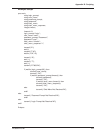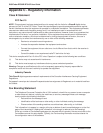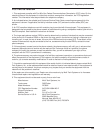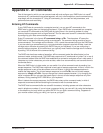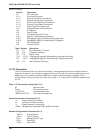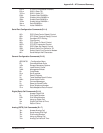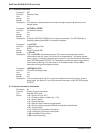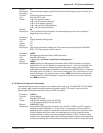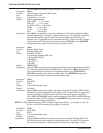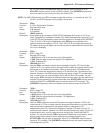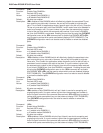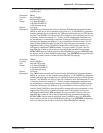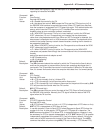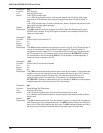
Appendix D - AT Command Summary
RF300E/RF310E 125
Default: I0
Description: The In command displays specific product information depending on the value of n.
Command: Ln
Function: List Active Profile Information
Unit: Decimal ASCII code
Values: n=0—List stored numbers
n=5—List AT command settings
n=6—List S-register summary
n=8—List Low-level ISDN Statistics
n=9—List Connection Statistics
Default: L0
Description: The Ln command lists information for various settings or lists various statistics
depending on the value of n.
Command: !L
Function: Display Network Configuration
Unit: n/a
Values: n/a
Default: n/a
Description: Use the !L command to display the TA’s current network configuration: MSN/DN,
SPID, TEI, Data protocol, switch type, etc.
Command: >MIBn
Function: Management Information Block (MIB) Information
Unit: Decimal ASCII code
Values: n=0 through n=(number of digital plus analog ports)-1
Default: >MIB0
Description: >MIBn displays the Management Information Block (MIB) information for the port
specified by n. If n is not specified, n is assumed to be 0. n=0 is the first digital port.
Digital port information is identical to the I11 information. Analog ports follow the
digital ports and analog port information is identical to the I12 information. If there are
two digital ports (n=0 and n=1), then the first analog port (if any) will be port n=2, the
second analog port (if it exists) is port n=3, etc. >MIBn simply allows a specific port
to display the I11 or I12 information of a port other than the one currently receiving
the >MIBn command.
D.1.3 Network Configuration Commands
Use the following commands to select your network switch type (e.g., EuroISDN NET3, VN4, INS64,
etc.), specify data directory/multiple subscriber numbers, specify TEI values if required, and to
specify other information required to make an ISDN connection.
Command: %A97=n
Function: Dialing Method
Unit: Decimal ASCII code
Values: n=0 (En bloc sending during call SETUP)
n=1 (Overlap sending during call SETUP)
Default: %A97=0 (En bloc)
Description: Standardized ISDN signaling protocols, such as DSS1, DSS2, and SS7, support a
sending complete indication; i.e., a signal that no more digits will follow. However,
appending such a signal to a telephone number is often impractical; therefore, many
private networks send the number of a called party by using a procedure called
overlap sending, in which no sending complete indication is sent. Computer users,
however, can automatically append the sending complete indication to the telephone
number by choosing the en bloc method of sending, which results in faster call setup.



